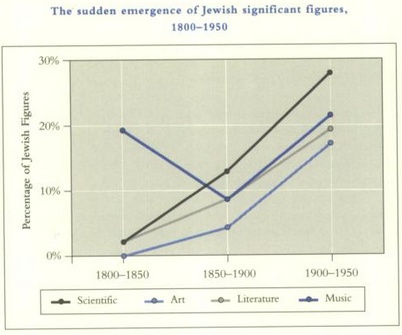Charles Murray has recently come under attack for the position he staked out in Human Accomplishment on gender and achievement. He’s ably defended himself by pointing out what he actually wrote. In the process, though, I remembered my favorite part of what is possibly his most underrated book.
While removing social and legal barriers often fails to release superlative achievement, sometimes it does. The most dramatic case of all: What transpired when the barriers of Europe’s Jewish ghettos came crumbling down. Murray:
During the four decades from 1830 to 1870, when the first Jews to live in emancipation (or at least to live under less rigorously enforced suppression) reach their forties, 16 Jewish figures appear. In the next four decades, from 1870 to 1910, when all non-Russian Jews are living in societies that offer equal legal protection if not social equality, that number jumps to 40. During the next four decades until 1950 – including the years of the Third Reich and the Holocaust – the number of Jewish significant figures almost triples, to 114. The figure below shows how these numbers work out as percentages of all significant figures for the three half-centuries from 1850 to 1950:

As Murray elaborates elsewhere:
Disproportionate Jewish accomplishment in the arts and sciences
continues to this day. My inventories end with 1950, but many other
measures are available, of which the best known is the Nobel Prize. In
the first half of the 20th century, despite pervasive and continuing
social discrimination against Jews throughout the Western world, despite
the retraction of legal rights, and despite the Holocaust, Jews won 14
percent of Nobel Prizes in literature, chemistry, physics, and
medicine/physiology. In the second half of the 20th century, when Nobel
Prizes began to be awarded to people from all over the world, that
figure rose to 29 percent. So far, in the 21st century, it has been 32
percent. Jews constitute about two-tenths of one percent of the world’s
population. You do the math.
To use Clemens, Montenegro, and Pritchett’s terminology, Murray is essentially estimating the “place premium” for Jewish achievement. As long as Jews remained in literal ghettos, most of their creative abilities were invisible – and wasted. In order to live up to their full potential, the Jews had to physically and intellectually migrate. Some declined to do so even after they had the option. But the rest took to social integration like fish to water – and the results are staggering.

READER COMMENTS
Al
Apr 7 2014 at 1:59am
Ironically, many of the critics exhibit similar analytical blinds as Charles Murray. The notion that women are “equal” and not “inferior” stems from the same framework that considers cognitive abilities as bounded by some fixed potential reachable in optimal situations. But the appearance of intelligence is shaped by the methods of its measurement, and by the values underlying such measurements. A positivist assertion about intelligence is meaningless without appreciating the reflexivity of human behavior.
gwern
Apr 7 2014 at 11:30am
What a pity there are no more ghettos to crack open: all the brainy groups and minorities have either migrated or improved their own environments. The Jews could emerge only once, China and Japan and South Korea could industrialize only once, etc.
dave smith
Apr 7 2014 at 11:31am
How useful is it to look so far into the tail of the distribution?
Nathan Smith
Apr 7 2014 at 3:55pm
Bryan doesn’t draw this out, but this seems like a parable for open borders.
Trapped in the ghetto, the Jews couldn’t achieve that much.
Allowed to integrate, their achievement soared.
Most of the human race is effectively in a ghetto, locked out from the most productive centers in the world economy by immigration restrictions.
The example of Jewish integration suggests that estimates of the global impact of open borders by Clemens, Kennan and others may greatly understate it. After all, Jewish high achievers had huge externalities. (Albeit some were negative: we could have done without the high achievements of Karl Marx and Leon Trotsky.)
Steve Sailer
Apr 7 2014 at 5:51pm
Jews had to self-liberate themselves.
Jews had been the white collar upper middle class of Poland-Lithuania-Ukraine for many centuries and saw little reason to integrate with the poorer, less educated, less intelligent gentiles. (See “Borat” for the traditional Jewish view of Slavs.) But Jews were so successful at increasing their population numbers relative to the host population that they more than filled all the good finance jobs and thus each generation had to go into more downscale trades to get by.
Moses Mendelssohn in the later 18th Century noted that the Germans were finally pulling ahead of the Jews and decided that Jews needed their own Enlightenment.
http://www.nytimes.com/2005/06/03/science/03gene.html?pagewanted=print
Ken from Ohio
Apr 7 2014 at 8:24pm
Can this concept be applied to other things…like athletics??
Can a case be made that certain minority groups have been released from the virtual ghetto of poor nutrition, poor access to pediatric health care (immunizations etc), and basic household amenities. And their inherent athletic ability is now allowed to flourish.
Is anyone brave enough to “do the math” on this? Or will political correctness scare us away from talking about this?
Floccina
Apr 9 2014 at 5:34pm
Ken I was about to write a similar post to yours. Blacks in USA have achieved amazing dominance in football and basketball in just a short time after they were allowed to participate. This is quite and achievement.
Comments are closed.